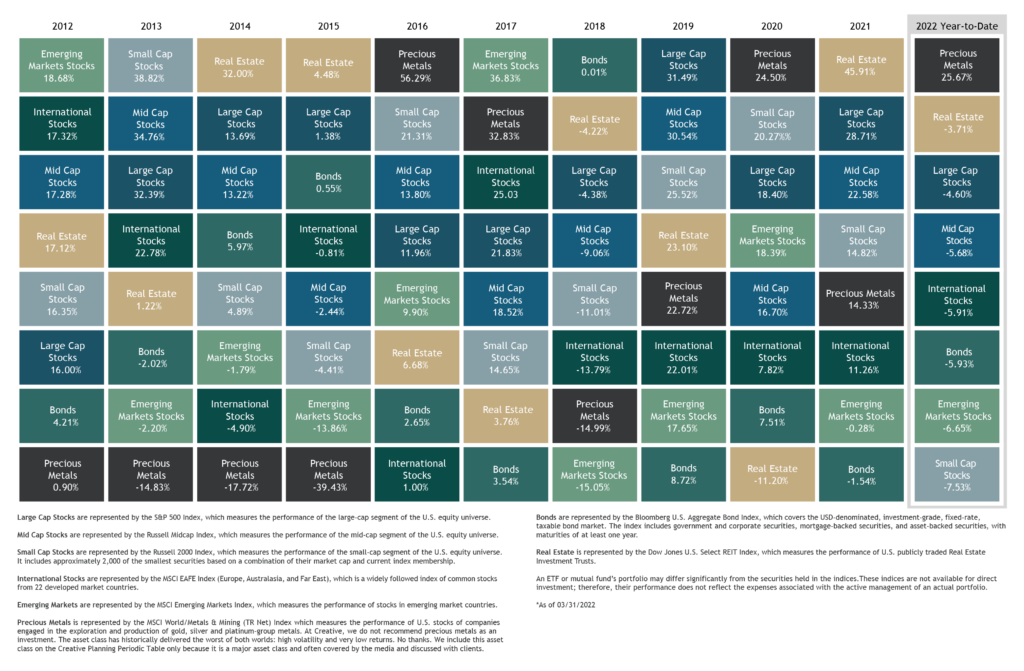How to Stay on Course
There’s no way around it – market volatility can be scary, especially if you are nearing retirement or have other major expenses on the horizon. Whenever you see your portfolio value drop by 10% to 20% over a short period of time, you may be tempted to sell out and stash a pile of cash. But as unnerving as volatile markets may be, they’re a normal part of investing. So because volatility is inevitable, the following are tips to help you weather the storm as a long-term investor.
Tip #1 – Stay invested.
Fear-driven selling may be the single biggest mistake investors make during periods of market volatility. These significant portfolio adjustments are typically driven from panic rather than sound investment principals. It’s very difficult (I’d dare go so far as to say it’s impossible) to time the market. Most investors who try doing so end up missing out on significant growth opportunities.
When speaking about market volatility, Creative Planning CEO Peter Mallouk often asks the one thing all bear markets have in common. The answer? They all eventually end.
There has never been a time in history where the market has not eventually recovered from a downturn. Yes, sometimes it takes years for the recovery to occur — and the rebound may not coincide with your investment timeline — but history shows markets will eventually rise again. However, if you take your money out of the market all together, you’ll realize any portfolio losses and miss out on an opportunity for future growth.
Consider the following chart1, which illustrates how missing just a few days in the market over many years can greatly impact a portfolio’s performance.
The next three tips can help you remain invested and poised for growth in a manner that’s comfortable and appropriate for you, based on your personal financial situation.
Tip #2 – Maintain a diversified portfolio.
Portfolios that are highly concentrated in a few investment types, sectors or industries can be risky. As illustrated in the chart below, the performance of various asset classes varies greatly from year to year, which is why it’s important to spread your risk out across multiple asset classes and investment types. Diversification typically helps avoid the severe downside of market fluctuations. To dampen volatility over time, diversify across asset classes, sectors and geography.
Annual Returns for Select Asset Classes 2

Tip #3 – Understand your risk tolerance.
When navigating volatile market conditions, it’s important to commit to and maintain an appropriate level of portfolio risk. Consider your risk tolerance, current financial situation, future income needs and long-term goals. Develop a financial plan and determine a level of portfolio risk you feel comfortable with in advance. And when volatility inevitably comes, hold true to this risk profile regardless of what the market is doing. Having a portfolio that’s too aggressive increases the likelihood you’ll make an emotionally driven decision to sell at the wrong time. On the other hand, having a portfolio that’s too conservative reduces long-term returns and could make it more difficult to outpace inflation and accomplish your financial objectives.
Tip #4 – Differentiate between long-term and short-term goals, and invest accordingly.
If you’ve read any of our other insights, you’ve heard us stress the importance of maintaining a long-term, goals-based approach to investing. Market volatility is no fun. Not only can a market drop result in a steep decline in your portfolio’s value but many news outlets and other investors can make volatility feel like the end of the world.
One way to deal with short-term market volatility while remaining focused on your long-term goals is by following what we refer to as the five-year rule. Using this approach, any assets you plan to use within the next five years should be conservatively invested. So, if in the next five years you anticipate a large expense, such as retirement, a new car, college tuition for a child or grandchild, a wedding, etc., you should have a sum of money invested in a short-term, semiliquid account. Your other assets should remain invested in a diversified portfolio in order to support your long-term goals.
By using this strategy, you can solve the challenge of funding short-term obligations while also remaining focused on your long-term goals because:
- Short-term assets are sheltered from daily market fluctuations, which can provide you with peace of mind that you will be able to fulfill your upcoming financial obligations.
- Long-term assets remain invested in a diversified portfolio with the potential to outpace inflation, take advantage of market opportunities and grow to fund your long-term goals.
Ultimately, the best way to grow your wealth in a volatile marketplace is by having a financial plan in place to help keep you on track toward your specific financial goals, regardless of market volatility.
At Creative Planning, we help clients develop customized and comprehensive financial plans specifically designed to help them achieve their long-term financial goals. If you’re ready to start planning for your financial future, please contact us.


